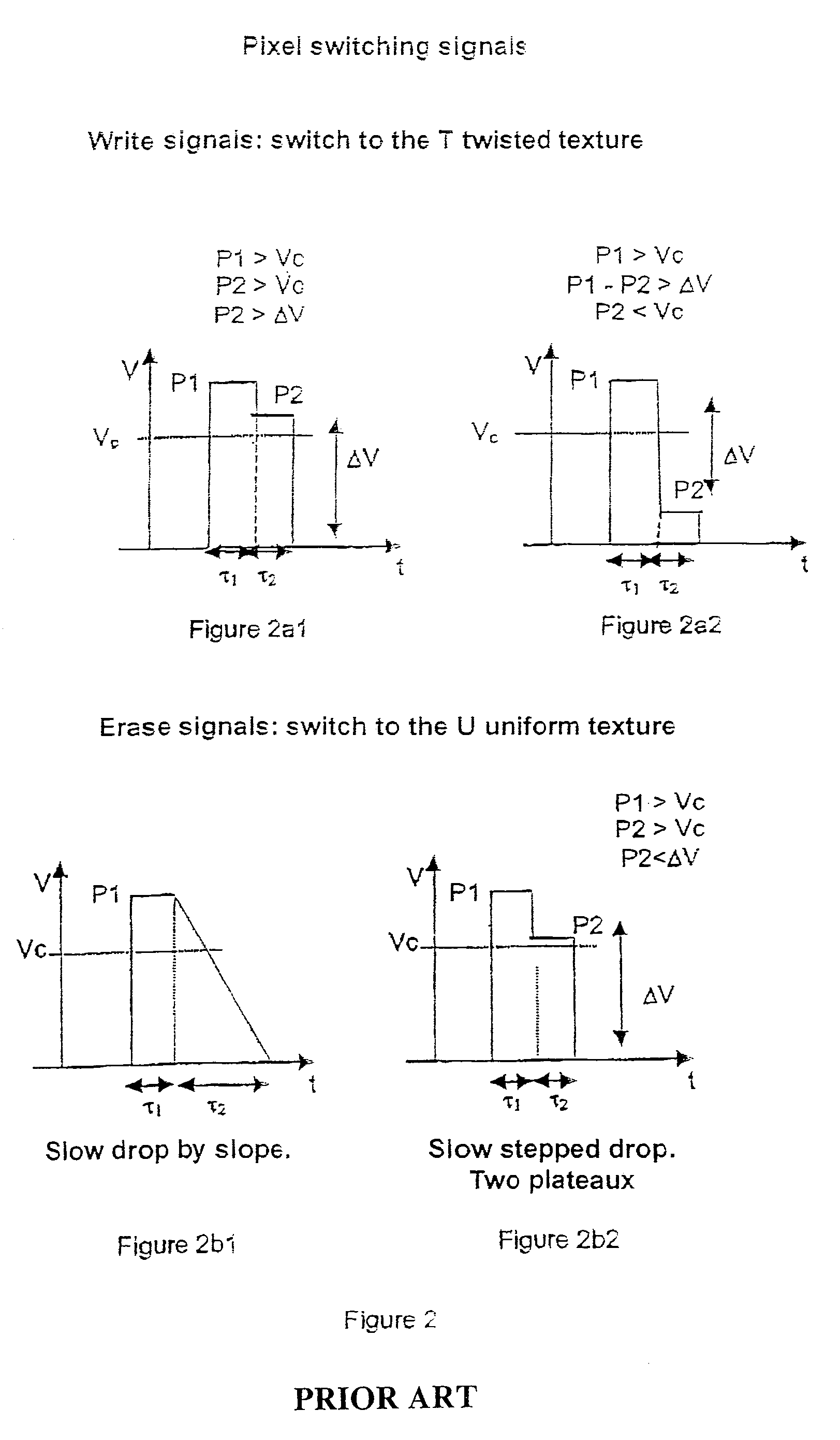Addressing process and device for a bistable liquid crystal screen
a liquid crystal display and bistable technology, applied in the direction of optics, instruments, non-linear optics, etc., can solve the problems of affecting the electro-optical response of the liquid crystal pixel, affecting the addressing process, and affecting the addressing time, so as to reduce the parasitic optical effect of addressing and reduce the time c
- Summary
- Abstract
- Description
- Claims
- Application Information
AI Technical Summary
Benefits of technology
Problems solved by technology
Method used
Image
Examples
example 1
[0105]By way of a first example, we will take a sloped type column signal. The amplitude of this signal increases linearly with time until it reaches a maximum peak voltage C″, then is brutally brought back to zero synchronised with the end of the line pulse.
[0106]The maximum value of the column signal C″ may be increased with respect to the classic value of C, which permits switching between the two textures (see electro-optical curve of FIG. 4).
[0107]An example of signals corresponding to example 1 of variant 2 is given in FIG. 12. Once again, on FIG. 12a we find: a line signal, FIG. 12b: an erase column signal, FIG. 12c: a write column signal, FIG. 12d: an erase pixel signal, and FIG. 12e: a write pixel signal. The column pulse has a duration of τC and the form of a slope of maximum C″.
[0108]The Vrms voltage of the parasite signals becomes in this case:
Vrms2=τCC″2 / 3(τ1+τ2)
[0109]In the previous numerical example and with for example τC=τ2 / 2 and C″=C=2V we have:
Vrms2=τ2C″2 / 6(τ1+τ2)...
example 2
[0117]By way of a second example, we will take a rising column signal with two plateaux, C1 and C2, with respective duration of τC1 and τC2. An example of signals corresponding to example 2 of variant 2 is given in FIG. 13. Once again, we can see on FIG. 13a: a line signal, FIG. 13b: an erase column signal, FIG. 13c: a write column signal, FIG. 13d: an erase pixel signal and FIG. 13: a write pixel signal. The column pulse has duration of τC=τC1+τC2 and the form of a double plateaux.
Experimental Results with the Two Variants
[0118]In order to demonstrate the pertinence of the invention, the optical transmission of a pixel of a BiNem screen during the addressing of an image was measured. Due to the arrangement of the polarisers, the uniform texture given in this case was the white optic state, and the texture written was the black state. When the line of the pixel is addressed, the pixel is changed to a uniform texture (white state) and then it is subjected to parasite column signals f...
PUM
| Property | Measurement | Unit |
|---|---|---|
| relax time | aaaaa | aaaaa |
| voltages | aaaaa | aaaaa |
| voltage | aaaaa | aaaaa |
Abstract
Description
Claims
Application Information
 Login to View More
Login to View More - R&D
- Intellectual Property
- Life Sciences
- Materials
- Tech Scout
- Unparalleled Data Quality
- Higher Quality Content
- 60% Fewer Hallucinations
Browse by: Latest US Patents, China's latest patents, Technical Efficacy Thesaurus, Application Domain, Technology Topic, Popular Technical Reports.
© 2025 PatSnap. All rights reserved.Legal|Privacy policy|Modern Slavery Act Transparency Statement|Sitemap|About US| Contact US: help@patsnap.com



